In recent years, China’s eCommerce ecosystem has demonstrated strong capabilities for attracting new customers through a diversified set of traffic channels. Nonetheless, with such fierce competition, how should brands convert these new customers into loyal fans?
User analyses from international brands reveal that a high proportion of members choose to leave in the second year, and according to data from Harvard Business Review, the lifetime value of customers participating in membership programs is 306% higher than that of non-members—this shows the importance of building excellent loyalty programs.
The cost of acquiring a customer can be 5x as much as retaining an existing one. Stay ahead of the competition with TMO’s Social Commerce solutions.
According to information from the Tencent Cloud Developer Community, the transaction volume of WeChat Mini-programs reached RMB 1.5 trillion in the third quarter of 2023, which indirectly shows the huge potential of mini-programs as a key tool for foreign brands to promote sales in China by strengthening member loyalty. In this article, we will introduce the key use cases for Member Loyalty Programs used within the WeChat mini-program ecosystem, as well as how top brands implement these mechanisms to boost sales.
Mini-programs: The ideal carrier for membership systems
Nowadays, consumers are increasingly accustomed to spending spare time shopping and browsing. Mini-programs, as lightweight applications that do not require downloading and can be used on the go, perfectly fit this consumption habit.
In addition, Chinese consumers are highly dependent on social platforms such as WeChat. By the end of 2023, the number of monthly active accounts of WeChat (both local and global versions) reached 1.327 billion.
Relying on the WeChat ecosystem, mini-programs can better reach the target audiences and directly grasp customer data, which not only includes customers’ purchasing behavior but also covers their browsing habits, interaction records, etc. Through this, brands can conduct refined classification and label management of customers, thereby achieving more accurate marketing.
In addition, mini-programs can also help brands reduce customer acquisition costs. According to iResearch, private traffic eCommerce operations exhibit higher repurchase and average order values without changing the cost of customer acquisition. It is through the design and operation of membership loyalty programs that brands can encourage old customers to repurchase as well as attract new customers through word-of-mouth communication from old customers. At the same time, through the use of marketing automation tools, brands can maintain continuous interaction with users at a low cost and increase the lifetime value of customers.
Implement gamification, targeted offers, and other promotional features with TMO’s Membership & Loyalty Program services.
Key Mini-program Uses to Strengthen User Loyalty
As the traffic becomes increasingly fragmented, the difficulty and cost of obtaining traffic from public platforms have increased significantly. In the Chinese market, membership loyalty programs have become the main means for many foreign brands to improve customer retention and increase customer stickiness. The role of private domain mini-programs in this regard is mainly reflected in the following aspects:
1. Offer a Personalized Member Experience
Accurate product recommendations, customized discounts, personalized interactions, and dynamic member services are some ways in which you can provide a personalized user experience. Through mini-programs, brands can leverage members’ behavioral data such as browsing and purchase history, interaction frequency, and other metrics to generate user audiences and recommend products or services that best suit each member’s preferences.
Additionally, brands can also design promotions for different membership tiers or life cycle stages. For example, they can provide first-purchase discounts for new members, point redemption mechanisms for old members, and send exclusive gifts to birthday members. This differentiated promotion strategy can enhance members’ sense of exclusivity and participation. Similarly, interactive content based on members’ interests and needs can also be pushed to the user.
For example, Herbalife provides members with personalized health assessments and result analysis in its mini-program, guiding users to contact health consultants for interpretation and purchase appropriate products.
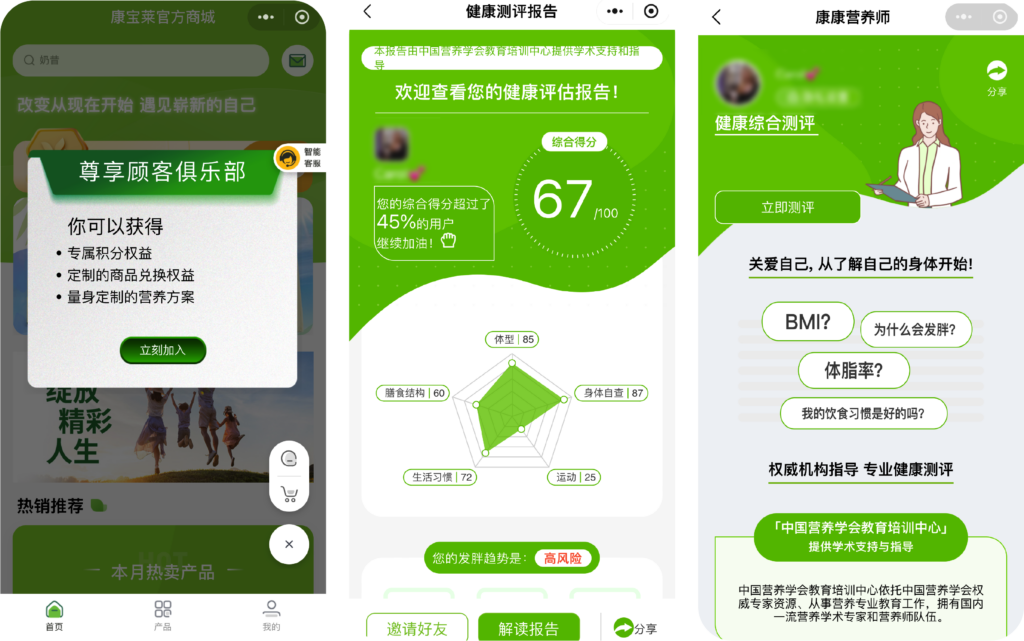
2. Diversify Customer Incentive Mechanisms
eCommerce mini-programs commonly feature a flexible points system where members can earn points by completing specific behaviors (such as purchasing, signing in, sharing products and content). Points can be exchanged for various rewards within the mini-program, such as coupons, gifts, exclusive services, and more. This incentive mechanism can not only increase the activity of members, but also promote members’ repeat purchases. Providing exclusive discounts and offers for different membership levels can not only motivate members to upgrade their levels, but also promote their consumption.
For example, GNC divides its members into five levels from “Newbie” to “Health Leader” based on their “growth value”, and provides upgrade gifts, different point-earning levels, birthday privileges, etc. Similarly, MAC’s membership loyalty program divides members into “Heart-beating Fans”, “New Fans”, “Advanced Fans” and “Top Fans” based on their purchasing behavior, and each stage provides different discounts and experiences, such as makeup customization, birthday gifts, customized PRO masterclasses, etc.
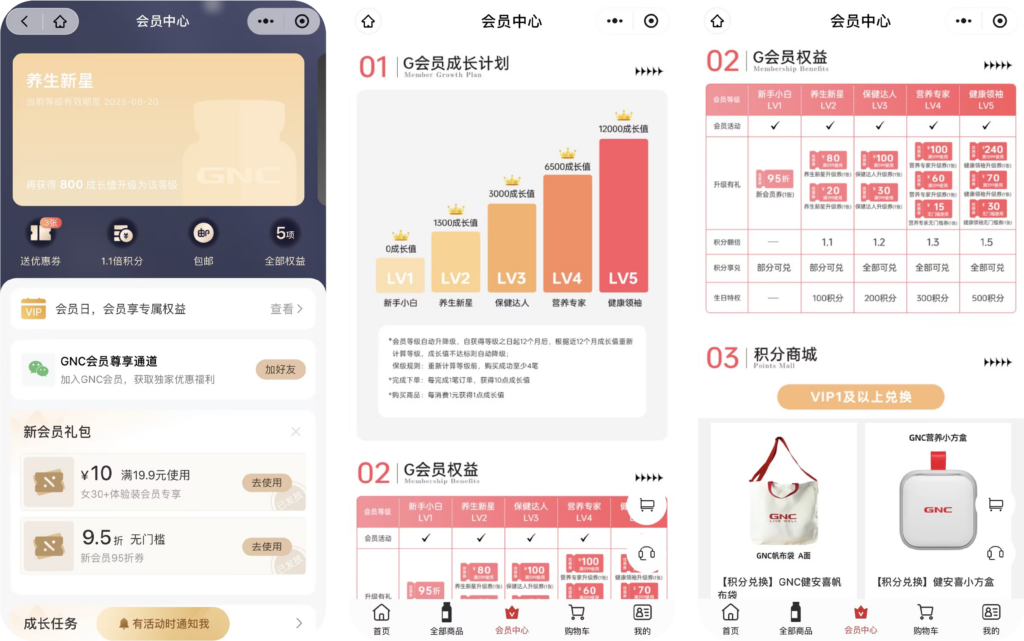
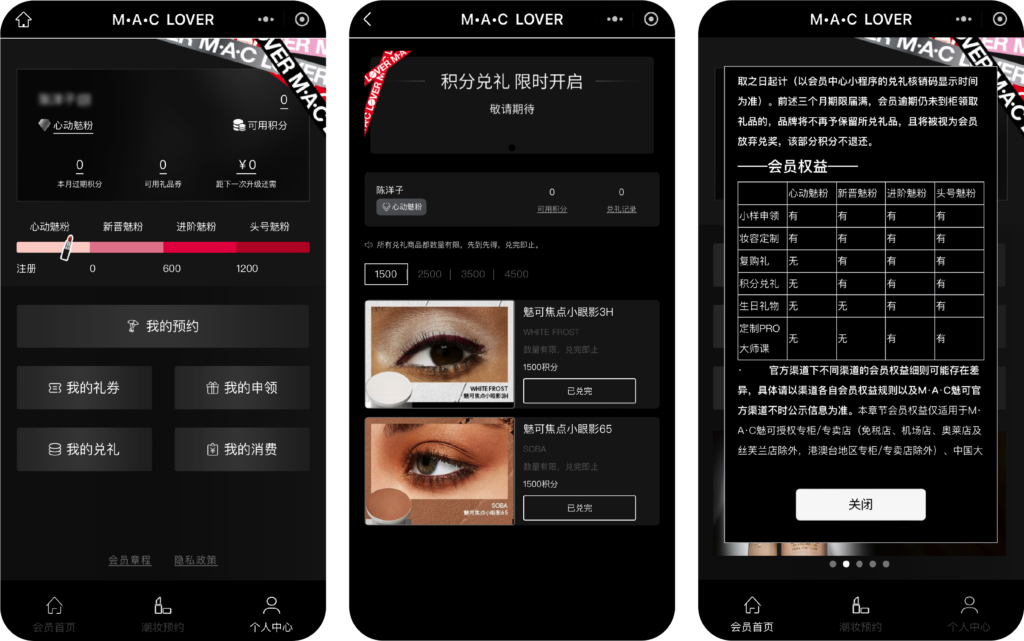
Brands can regularly launch limited-time sales or flash sales and encourage users to actively participate. Such activities are usually set up as member-only events to further enhance their sense of belonging and specialness. This sense of urgency and scarcity can often significantly increase their willingness to buy and participate.
Brands can also provide members with exclusive content or activities through mini-programs, such as new product launches, online live broadcasts, etc. These exclusive contents can also strengthen members’ sense of identity with the brand.
Build social proof, grow, and engage your customer base with Social Commerce Solutions specifically designed for China’s eCommerce ecosystem.
3. Fission Marketing & Word-of-Mouth
Since mini-programs are deeply integrated within the WeChat ecosystem, social sharing is extremely convenient: users can share products, activities, coupons and other content form the mini-program into their WeChat Moments or send to friends with one tap. In this way, brands can leverage users’ social relationship chains to achieve widespread dissemination of information.
Brands can also use mini-programs to carry out group buying or group purchasing activities that are a common practice in China. By inviting a certain number of friends to participate, users can enjoy preferential prices. This method not only enhances the user’s sense of participation, but also uses the power of social channel as a source for new customer acquisition and increases brand exposure.
Additionally, brands can encourage users to generate and share their own content, which can be sharing their orders, user experience, video presentations, etc. The dissemination of these user-generated content (UGC) on social platforms is often more natural and persuasive. Brands that encourage users to share their purchase and product experience through reward mechanisms such as points or coupons achieve a wider range of word-of-mouth communication. For example, Sephora built a “Meiyin Community” section in its WeChat mini-program to obtain “Beauty Points” as a reward when share real product experience, generating sharing, likes, comments and other interactions for the brand as a result.
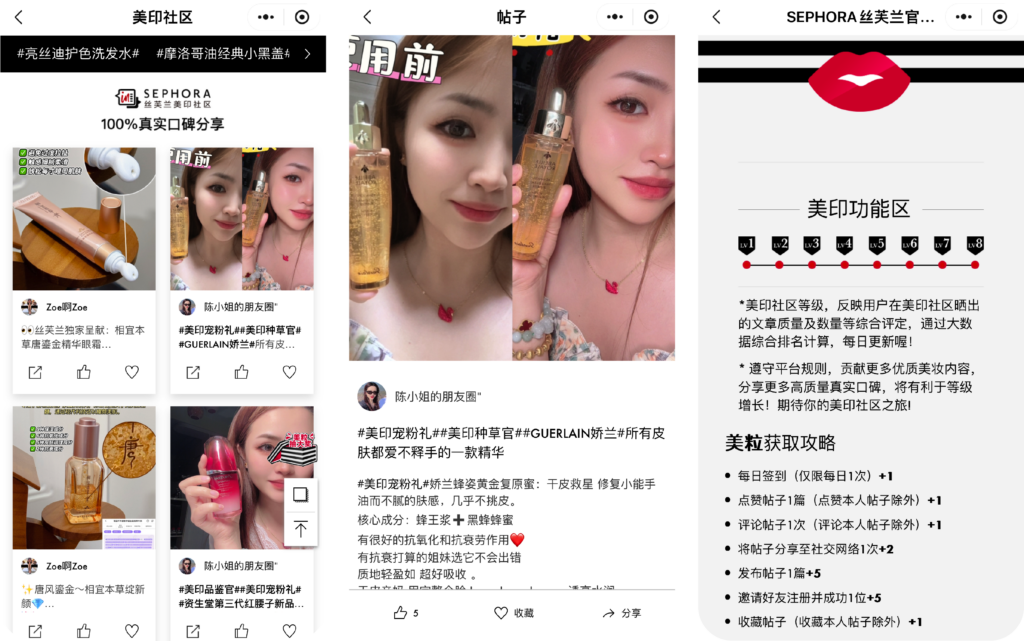
Brands can design a member recommendation or invitation mechanism to reward existing users for recommending new customers. After successfully inviting friends to register or purchase, both the referrer and the referee can receive rewards. This two-way incentive mechanism can greatly mobilize the enthusiasm of users and quickly expand the user base.
This way, mini-programs can quickly detonate the viral effect of social platforms by seizing social hot spots or planning viral marketing activities. For example, brands can use trending topics, holiday marketing, or public welfare activities to guide users to share and participate, thereby achieving explosive communication effects. For example, Dolce & Gabbana launched the “New Year Dragon Gachapon (Capsule Toy)” mini-program in the Year of the Dragon. Users can select different keywords to generate exclusive emoji packages for the Year of the Dragon and share them with friends.
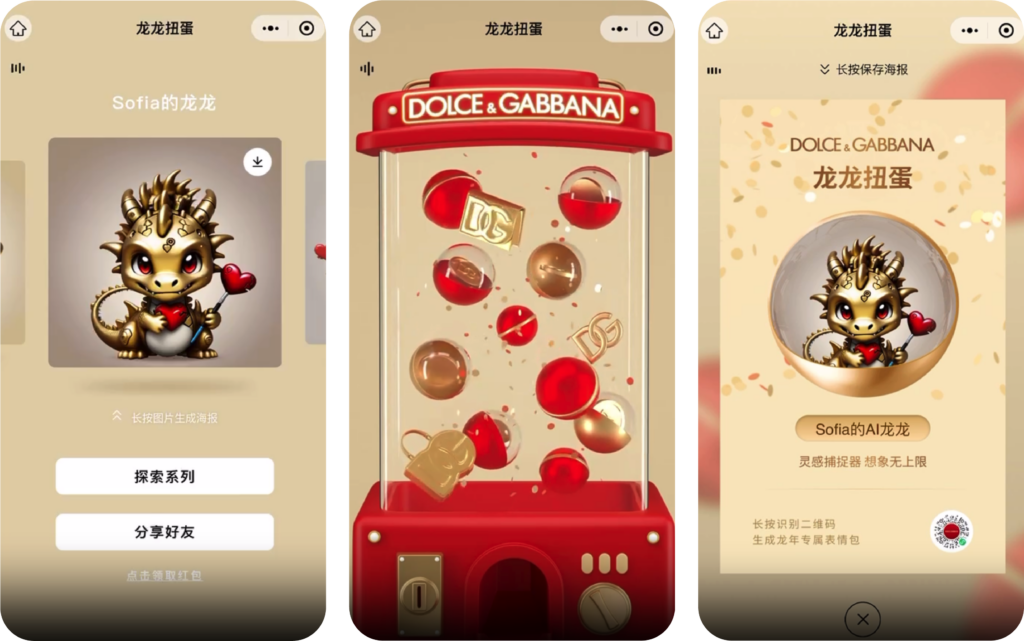
4. Member Lifecycle Management
Mini-programs have significant advantages in member life cycle management, and can help brands effectively attract, maintain, and enhance the value of members at different stages:
- For the initial stage of the member lifecycle, brands need to use effective strategies to attract new customers to register as members. Providing first-time registration discounts, giving new members gifts or free trials are some ways to funnel new visitors into joining through the WeChat mini-program and when combining it with promotional activities on social platforms, brands can quickly expand their membership base.
- After successfully recruiting members, it is crucial to keep them active through a series of interactive activities and content push. For example, brands can encourage members to frequently visit mini-programs and participate in interactions through regular member-exclusive activities, limited-time discounts, and point redemption. Personalized recommendations and push content are also very important at this stage. Brands can accurately recommend products and content that suit members’ interests based on their purchase history and browsing history, thereby increasing member engagement and consumption frequency.
- In the member maintenance stage, as the membership relationship develops, brands need to take measures to maintain the loyalty of existing members. At this stage, mini-programs can enhance members’ sense of belonging through member-exclusive benefits, birthday gifts, etc. For example, brands can provide exclusive VIP services or discounts to old members, such as advance pre-orders, new product launch notifications, etc., to strengthen member loyalty.
- During the member awakening stage, brands need to adopt effective reactivation strategies for members who have entered a silent period or have lost members. Brands can identify these dormant members through data analysis and customize personalized reactivation plans for them. Common methods include sending incentive coupons, limited-time discounts, and special care “check-ins” to stimulate members to re-engage. For example, Calvin Klein will remind users of expiring offers through text messages and other forms.
- In the mature stage of the member life cycle, brands should enhance members’ sense of belonging and loyalty through personalized services and experiences. By providing higher membership benefits, enhancing emotional connections, and customizing services, brands can not only further tap the consumption potential of high-value members, but also ensure that they remain loyal to the brand in the long term.
Build a High-converting eCommerce Strategy with TMO
Through private traffic, brands can not only better control customer data and achieve precise marketing but also create a sustainable membership ecosystem, significantly improving customer loyalty and brand market competitiveness.
TMO has extensive experience in WeChat eCommerce development. Through private domain mini-programs, WeChat Store and other mechanisms, we are committed to helping brands succeed in the Chinese market. We provide you with solutions suitable for various eCommerce models and integrated multichannel management to ensure that your brand stands out in this highly competitive market. (Source: TMO Group)
